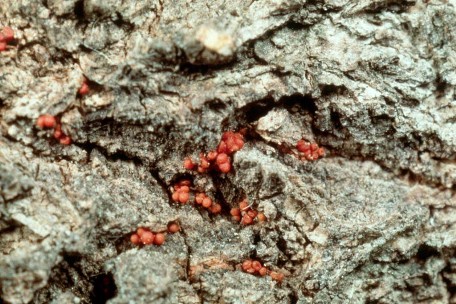Almost any hardwood tree that has been injured is prone to sickness. If a tree has areas that appear slightly sunken in almost canker-like sores, the tree may have Nectria. Nectria is a fungal disease that can affect almost any tree, even hardwoods. This is especially true if the tree has an injury, which makes it important to care for your trees.
The Nectria fungus is a very aggressive fungus, and will mercilessly attack any injured trees. Nectria doesn’t take any breaks, and stays active throughout the year, as long as the temperature stays above freezing.

Photo credit to tidcf.nrcan.gc.ca
Never Hurt A Tree In the Fall
The fall is generally the wettest season, and thus puts injured trees at increased risk of Nectria attack. Never cut or otherwise harm a tree during the fall, as the moisture in the wound provides the perfect breeding ground for Nectria.
In the dry seasons, remove any branches that have been invaded by Nectria. As a means of preventing Nectria in recently transplanted trees, avoid having the tree suffer through a drought or other kinds of stress. Keep newly transplanted trees under close care for a couple of years.
Freeze Damage Can Invite Nectria
Younger trees can suffer from freeze damage, and because Nectria is active all year long, it can invade your tree. All around the world the Nectria fungus causes diseased trees, and this can be especially seen in hardwood trees. A Nectria canker sore, the result of the Nectria fungus, can affect more than 60 types of trees, such as apple trees, birch trees, dogwood trees and many more. Another disease that is very similar to Nectria can affect the magnolia family as well.
It is very common during spring and fall, but because it is active all year round, it is best to be on the lookout for symptoms of Nectria all the time. As long the temperature is above freezing and there is enough moisture, a wounded or stressed tree can fall victim to Nectria. Things such as drought and severe cold are extremely stressful to trees and can lead to Nectria.
Look for the following signs of Nectria
* Sunken and discolored areas near injuries
* Callus Tissue development and creamy white or red fruit structures developing
* Sudden wilting or lack of leaf production
For help with keeping your trees healthy, call Great Northern Regreenery at 905-775-7444 for information about their tree disease control services.





